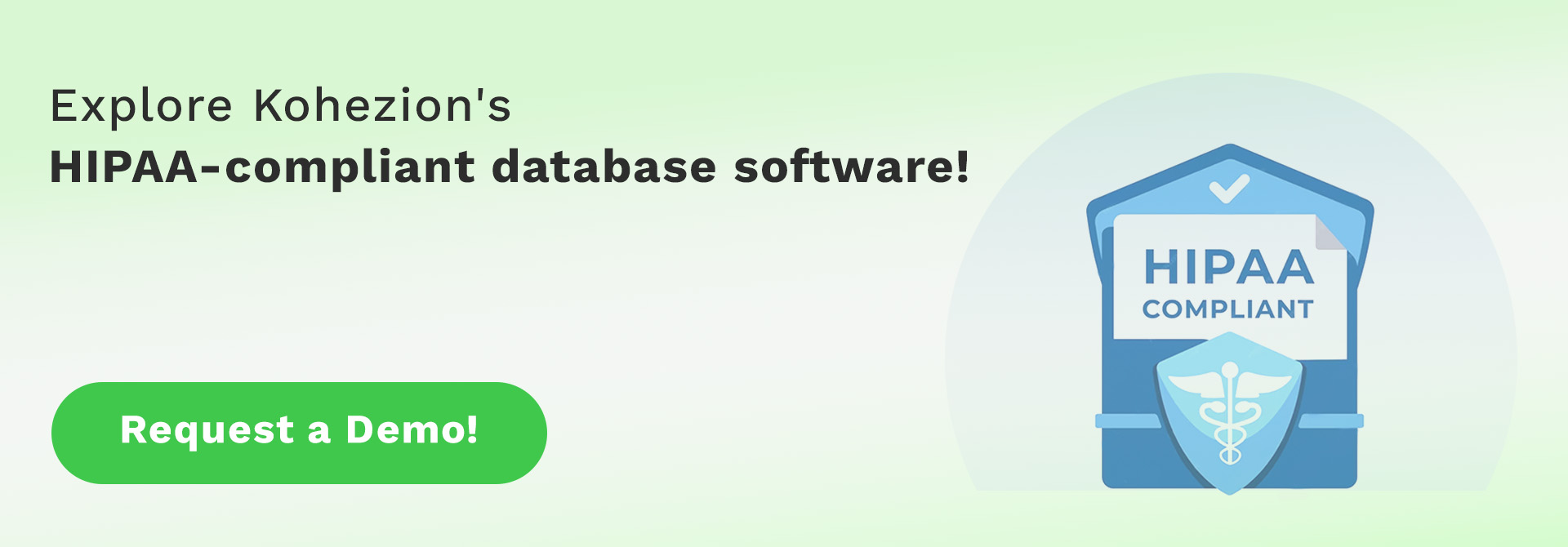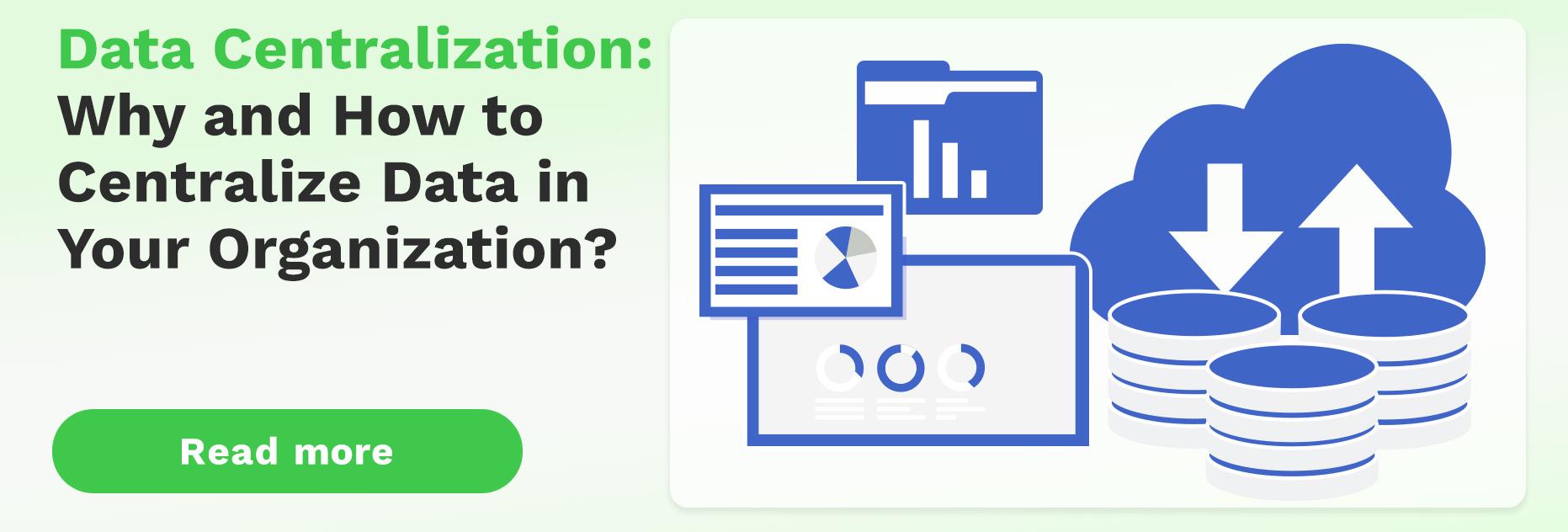Implementing Role-Based Access Control (RBAC) in your organization involves defining specific roles, assigning corresponding permissions, and regulating user access based on their roles. The role-based access control market is expected to increase at a compound annual growth rate of 12.2%. With a structured RBAC framework, you can enhance security, create automated workflows, and ensure that employees have appropriate access levels aligned with their responsibilities.
We'll buid your first application for you. At no extra cost.
Let us build your first business application for free. Go from an idea to an application in under 2 weeks.

What is Role-Based Access Control?
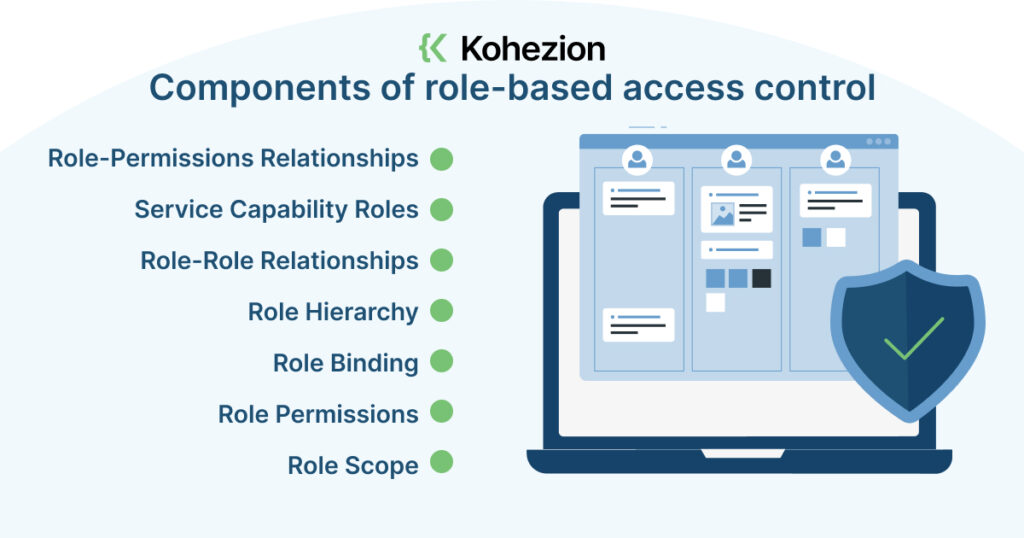
Role-Based Access Control (RBAC) is a method for restricting network access based on the roles of individual users. It allows organizations to assign specific privileges and permissions to employees based on their roles and responsibilities. The key components of RBAC include authorizations, responsibilities, and job competency, which determine the roles assigned to users.
These roles can range from end-users to administrators or expert users, and their access to computing resources can be limited to specific operations like viewing, creating, or modifying files. RBAC ensures that employees can only access the information and perform the tasks necessary for their jobs, preventing unauthorized access to sensitive data and applications.
Components of role-based access control
1. Role-Permission Relationships
Role-permission relationships define the specific actions and objects that a role is allowed to access, ensuring that users only have the necessary permissions to perform their designated tasks. Here is a structured explanation of the key components and characteristics of role-permissions relationships:
- Permissions: Permissions refer to the list of actions or operations that a role can perform on specific objects. For example, a contributor role may have permissions to access and modify a document, but not to delete it or open embedded links.
- Objects: Objects represent the resources or entities that are being accessed or operated upon. These can include documents, APIs, modules, or any other relevant components of the system. For instance, a marketing module may have permission to create and distribute newsletters, while an event module may have permission to create and manage event registrations.
- Roles: Roles are collections of permissions that can be assigned to users. Assign roles rather than individual permissions to easier manage and adjust access rights for multiple users. Roles can be hierarchical, with superior roles having more privileges than lower roles. For example, a document owner role may have more permissions than a contributor role.
- Role Assignments: Role assignments determine which roles are assigned to specific users or groups. These assignments can be transitive, meaning that if a user is a member of a group that has a role assignment, they will inherit the permissions of that role. For example, if a user is a member of a group that has the Organizer role assignment, they will have the permissions associated with that role.
- Overlapping Role Assignments: In the case of overlapping role assignments, the effective permissions are the union of the assigned roles. This means that if a user has multiple roles with overlapping permissions, they will have the combined set of permissions from all those roles. For example, if a user has both the Organizer and Registrant roles, they will have the permissions to view, create, edit, and register for events.
2. Service Capability Roles
These roles are designed to align with specific service capabilities within the organization, ensuring that users have the necessary privileges and permissions to perform their designated tasks. With the assignment of service capability roles, organizations can effectively manage access to resources and maintain control over their IT infrastructure. The following points outline the key aspects of service capability roles in the context of RBAC implementation:
- Service-Oriented Approach: Service capability roles are defined based on the specific services or functions that the organization offers. These roles are created to align with the responsibilities and tasks associated with each service, ensuring that users are granted appropriate access privileges.
- Granular Access Control: Service capability roles assign specific permissions and privileges to each role and enable organizations to implement granular access control. This ensures that users only have access to the resources and functionalities necessary for their designated service capability, minimizing the risk of unauthorized access or misuse of resources.
- Hierarchical Structure: Service capability roles can be organized in a hierarchical structure, where higher-level roles have more privileges and permissions than lower-level roles. This hierarchical arrangement allows for better control and management of access rights within the organization.
- Evolution of Roles: As the organization evolves and introduces new services or modifies existing ones, review and update the service capability roles accordingly. This ensures that users have the necessary access to new resources and functionalities. Regularly revisiting and updating service capability roles helps in maintaining an accurate and up-to-date access control system.
- Collaboration and Input: Designing service capability roles requires collaboration and input from various stakeholders, including managers, business leaders, and application owners. Their expertise and understanding of the services and functions within the organization define the access requirements for each role. Collaborative efforts ensure that the assigned roles accurately reflect the needs and responsibilities of different service capabilities.
- Role Discovery Process: The process of defining service capability roles involves a combination of art and science. It requires collaboration across IT, HR, and executive leaders to identify and group users based on their shared access needs. This role discovery process helps in understanding the access requirements of different service capabilities and ensures that the assigned roles are comprehensive and aligned with the organization's objectives.
- Avoiding Over-Complexity: Define service capability roles that accurately reflect the access needs of different services to avoid over-complexity. Defining too many roles can lead to confusion and difficulties in managing access control. To strike a balance, define an optimal number of roles that effectively capture the necessary access requirements without creating unnecessary complexity.
- Regular Review and Maintenance: Regularly review and maintain the service capability roles to ensure their relevance and effectiveness. As the organization evolves, update or retire the roles to align with changing service capabilities. Regular reviews help in identifying any gaps or overlaps in access control and allow for adjustments to be made as needed.
3. Role-Role Relationships
In RBAC, roles are used to determine the privileges and permissions that can be assigned to users. These roles are often organized in hierarchies, where higher-level roles have more privileges than lower-level roles. The relationships between roles help to define the access rights and responsibilities within an organization's system.
- Role-Based Privileges: Roles in RBAC dictate user privileges and permissions, often organized hierarchically, where higher roles hold more authority.
- Simplified Permission Management: Roles collect permissions, and they group, add, remove, or modify permissions across multiple users, enabling easier administration.
- Hierarchy Establishment: Role-role relationships define hierarchical structures determining access levels; higher roles possess more privileges than lower ones, exemplified by document management, where an owner role holds broader permissions than a contributor role.
- Delegation and Access Control: Role relationships enable responsibility delegation, ensuring appropriate access levels aligned with job functions, and preventing unauthorized access and potential breaches.
- Determinants of Role Relationships: Factors like job designations, session attributes, and user traits influence role relationships, allowing for custom roles tailored to organizational needs.
- Interdepartmental Coordination: Defining relationships necessitates alignment among departments, especially challenging in larger organizations where defining roles might lack input from key decision-makers.
- Role-based Permissions for Modules: Roles collect permissions for specific modules (e.g., marketing or event). They assign tasks based on responsibilities and simplify access management.
- Organization-Specific Roles: RBAC accommodates organization-specific roles, crucial in multi-tenant setup or SaaS setup, granting or limiting access based on the user's associated organization for heightened security and precise access control.
4. Role Hierarchy
The role hierarchy is a fundamental component of RBAC, as it establishes the relationships between roles and determines the level of access each role possesses. This hierarchical structure provides a clear framework for granting and inheriting permissions. Components of the role hierarchy:
- System-Defined Roles: RBAC typically includes a set of predefined roles that come with specific privileges and permissions. These system-defined roles serve as the foundation of the role hierarchy. Examples of system-defined roles may include "SYSADMIN" or "ORGADMIN." "ORGADMIN" is a separate system role that manages operations at the organization level and is not included in the hierarchy of system roles.
- Custom Account Roles: Organizations may create additional roles specific to their needs and requirements. These custom account roles are user-defined and are granted privileges according to the organization's access control policies. Custom account roles can be assigned specific sets of permissions that align with the responsibilities and job designations within the organization.
- Database Roles: In RBAC, database roles are used to manage access to specific databases or database objects. These roles can be assigned to users or other roles within the system. The hierarchy of database roles allows for the inheritance of privileges from higher-level roles to lower-level roles. For example, a higher-level custom account role may be granted to a lower-level custom role, allowing the lower-level role to inherit the privileges of the higher-level role.
- Privilege Inheritance: The role hierarchy in RBAC enables the inheritance of privileges from higher-level roles to lower-level roles. When a role is granted to another role, the lower-level role inherits the privileges of the higher-level role. This means that users assigned to the lower-level role will have all the privileges associated with both the lower-level role and the higher-level role. Privilege inheritance reduces the need to assign individual permissions to each use and allows for efficient management of access control.
5. Role Binding
Role binding attaches role definitions to users, groups, service principals, or managed identities at a specific scope for the purpose of granting access. Organizations can create role assignments and grant access to resources and functionalities to individuals or groups based on their assigned roles.
- Process of Association: Role binding involves associating roles with users, groups, or entities, and defining their permissions and privileges within the system or application. This process groups roles instead of assigning individual permissions and streamlines permission management.
- Role Hierarchy and Permissions: RBAC's hierarchical roles determine user actions; for instance, a document owner role may have broader permissions than a contributor role, ensuring appropriate access based on job roles, session attributes, login credentials, and user traits.
- Methods of Role Binding: Role binding methods include Azure tools like the portal, CLI, PowerShell, SDKs, or REST APIs, providing flexibility in assigning roles based on organizational preferences and needs.
- Custom Role Creation: While pre-built roles exist, role binding accommodates custom roles tailored to unique organizational needs, allowing precise assignment of permissions to users or groups as per their tasks.
- Group Transitivity: Role inheritance within groups grants users permissions from parent groups, streamlining permission management for complex organizations with hierarchical structures, applying role assignments at higher levels, and distributing them to relevant users through group memberships.
- Separation of Duties: Role binding assigns different roles to individuals or groups and supports separation of duties, preventing excessive privileges and potential security risks or conflicts, ensuring a proper system of checks and balances, and reducing unauthorized access or misuse of privileges.
6. Role Scope
Role scope defines the set of resources to which the access and permissions of a role apply. Define the scope to further limit the actions allowed by a role, ensuring that users only have access to the necessary resources and functions. This helps in maintaining security and preventing unauthorized access to sensitive information. The components of role scope in RBAC:
- Management Group Scope: At the highest level of scope, a management group represents a collection of subscriptions and resource groups. Assign roles at the management group level to apply for access permissions across multiple subscriptions and resource groups within that management group. This ensures consistent access control across related resources.
- Subscription Scope: A subscription represents a billing unit in Azure and can contain multiple resource groups. Assign roles at the subscription level to control access to all the resources within that subscription. This is useful for granting permissions to specific sets of resources or segregating access based on different departments or projects within the organization.
- Resource Group Scope: A resource group is a logical container that holds related resources in Azure. Assign roles at the resource group level to control access to all the resources within that resource group. This allows for more granular access control, as roles can be assigned to specific resource groups based on the needs of different teams or projects. It also enables easier management and delegation of responsibilities within the organization.
- Resource Scope: At the lowest level of scope, roles can also be assigned directly to individual resources. This allows organizations to have fine-grained control over access to specific resources, such as virtual machines, databases, or files. Assign roles at the resource level to ensure that only authorized users have access to sensitive or critical resources.
The relationship between these components is hierarchical, with each level inheriting the access permissions from its parent level. This means that assigning a role at a higher level, such as a management group or subscription, will automatically grant access to all the child resource groups and resources within that hierarchy. However, roles assigned at lower levels, such as resource groups or resources, do not grant access to higher-level scopes.
Advantages of role-based access control
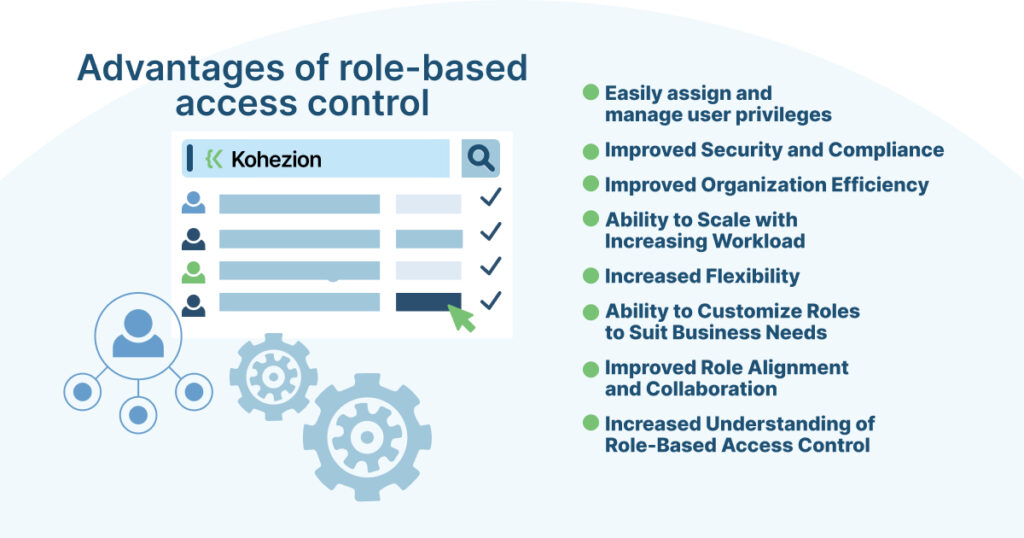
1. Easily assign and manage user privileges
Role-Based Access Control (RBAC) simplifies user privilege management within an organization. It associates them with specific roles rather than individual permissions and streamlines the assignment and maintenance of access rights. The benefits of RBAC in this area include systematic permission assignment, efficient data access audits for corrections, swift role addition or modification, minimized errors in permission allocation, and simplified integration of third-party users. RBAC's structured approach ensures compliance with legal and industry regulations, enhancing security while managing user access efficiently.
2. Improved Security and Compliance
RBAC aligns access permissions with defined roles and assists in regulatory compliance, ensuring adherence to standards like HIPAA, SOX, and ISO 27001. It enhances auditability, as it tracks system access and modifications, aiding in compliance checks and demonstrating adherence to privacy and security standards. RBAC's structured approach streamlines access management, automating permission assignments, reducing manual tasks, and minimizing errors in access allocation.
This framework mitigates data breach risks, as it restricts access to sensitive information, reducing unauthorized access possibilities, and managing permissions for third-party vendors efficiently. RBAC's flexibility also enables easy role and permission management, adapting swiftly to evolving business needs and simplifying global changes across various systems and applications.
3. Improved Organization Efficiency
RBAC simplifies access rights assignment, reducing administrative burdens and manual workflows. Automation within RBAC software automates role and permission assignments, decreasing manual tasks and paperwork for administrators. RBAC's systematic approach swiftly adapts access permissions during employee transitions and improves onboarding and offboarding.
RBAC's flexibility enables quick adjustments to roles, aligning access management with evolving organizational needs while minimizing potential errors in permission assignments. Also, its predefined roles facilitate the integration of third-party users, ensuring efficient and controlled access to resources, reducing risks, and limiting privileges to essential levels.
4. Ability to Scale with Increasing Workload
RBAC's scalability drives enhanced organizational efficiency in several ways. Its flexible access rules accommodate teams managing diverse and evolving resources, preventing bottlenecks and disruptions during access provisioning. This flexibility complements RBAC's role-based structure, allowing seamless scaling without compromising prior investments in the system. RBAC simplifies user provisioning, as it precisely assigns roles, reducing the need for constant access requests and streamlining onboarding and offboarding processes.
It also categorizes and streamlines access across multiple applications and platforms, effectively managing evolving access requirements as workloads increase. This streamlined access management ensures employees have appropriate access levels while maintaining robust security measures. You can also implement role-based access control as part of your IT operations automation for improved security and efficiency.
5. Increased Flexibility
RBAC's flexibility empowers organizations to manage access based on individual roles, offering a more adaptable approach to access control. Its medium level of flexibility allows seamless scaling to match the evolving infrastructure needs, crucial for teams handling extensive and dynamic resources. With RBAC, permissions assigned to roles can be easily adjusted, ensuring adaptability to organizational changes without compromising previous system investments. User provisioning becomes more straightforward with RBAC, swiftly assigning appropriate roles to new hires. This process simplifies resource access while reducing manual permission management efforts.
RBAC also offers a structured approach to access control, simplifying auditing tasks and clearly delineating permissions per role. Also, RBAC aligns with security best practices like the Principle of Least Privilege and the Zero Trust model, ensuring that users have access only to necessary resources and continuously verifying access requests against predefined roles and permissions. This approach reduces reliance on individual trust, emphasizes continual validation of access, and bolsters security.
6. Ability to Customize Roles to Suit Business Needs
RBAC's standout feature lies in its capacity to tailor roles to an organization's specific needs, ensuring employees access resources in line with their responsibilities while upholding security and compliance. Customized roles in RBAC deliver multiple advantages, optimizing access control systems to meet unique requirements. This customization allows for fine-grained access control, allowing organizations to precisely define permissions based on job functions, mitigating unauthorized access risks. RBAC's flexibility enables easy adaptation, permitting swift role additions, modifications, or removals to match evolving business landscapes without intricate manual adjustments.
RBAC customizes roles to meet regulatory standards and reinforces compliance and security, safeguarding sensitive data and enforcing segregation of duties to prevent misuse. Customized roles also streamline administration, simplifying the assignment of access rights based on predefined roles, centralizing access management, and diminishing administrative complexities and errors.
7. Improved Role Alignment and Collaboration
Role-based access control (RBAC) offers several advantages in terms of improved role alignment and collaboration within an organization. Firstly, RBAC allows for a clear and systematic categorization of roles based on shared access needs. This ensures that each role is defined in a way that aligns with the company's goals and takes into consideration the functional access needs of the individuals within those roles. RBAC involves business managers, IT, HR, and executive leaders in the process and promotes collaboration and a better understanding of the ideal structure of the organization.
This collaborative approach helps to avoid misalignment between roles and permissions, ensuring that individuals have the appropriate level of access to perform their job responsibilities effectively. RBAC also provides a framework for ongoing role management, allowing for easy updates and adjustments as the organization evolves. This adaptability ensures that roles remain aligned with the changing needs of the organization and helps prevent security gaps and compliance challenges.
8. Increased Understanding of Role-Based Access Control
Implementing RBAC systematically assigns permissions based on roles, preventing unauthorized access. RBAC ensures auditable user privileges, aligning access with needs. Its flexibility allows easy role adjustments across systems for consistency. RBAC helps comply with regulations like HIPAA, securing sensitive data. It also mitigates data breach risks, as it controls access to sensitive information and supports compliance through clear user access records for audits.
9. Improved Audit and Tracking Capabilities
RBAC assigns roles and permissions systematically and facilitates better auditing and tracking. It enables administrators to monitor access, detect unauthorized activities, and swiftly address any identified risks. RBAC's structured approach ensures compliance with regulations, such as SOC 2, safeguarding data and improving brand reputation. RBAC's role-based access ensures appropriate permissions, reducing errors, simplifying access management, and decreasing the need for excessive administrative support. RBAC also minimizes third-party risks, as it provides defined access for external entities, aligning with privacy and regulatory requirements, such as GDPR, LGPD, PIPEDA, and industry-specific standards.
10. Cost Savings through Reduced Overhead
RBAC implementation yields cost savings, as it reduces operational overhead. Its role-based approach minimizes IT support and administrative work and manages permissions based on roles, freeing up resources for strategic projects. RBAC streamlines onboarding and offboarding, cutting provisioning time and effort. This efficiency reduces downtime and enhances productivity. RBAC also ensures compliance with diverse regulations like GDPR and HIPAA, mitigating the risk of fines and penalties. It also minimizes errors in permission assignment, lowering the likelihood of security incidents and subsequent financial and reputational costs.
Disadvantages of role-based access control
1. Complexity of system setup
Setting up Role-Based Access Control (RBAC) systems demands a meticulous process involving inventorying IT systems, defining roles, and creating integration timelines. Challenges arise due to the complexity of this setup, including trial and error, managing permission requests, and maintaining balanced access levels among users in similar roles.
2. Increased complexity of role management
Defining roles requires coordination across departments, often daunting without collaboration with HR or executive input, leading to misalignment with company objectives. Adapting permissions to evolving needs risks over-assigning or mismanaging roles, creating security gaps. Managing organizational changes complicates role upkeep, necessitating regular updates to avoid obsolete roles causing misuse and security risks. Successfully navigating these complexities demands dedicated resources, collaborative efforts, and ongoing monitoring to prevent privilege issues and security vulnerabilities.
3. Increased workload for IT teams
Coordinating role categorization and access management demands a deep understanding of the organizational structure and technical infrastructure, challenging without collaboration. Regularly updating user roles to match evolving IT resources adds to the workload, ensuring users have appropriate permissions. Role and access discovery necessitates collaboration among IT, HR, and executives, contributing to IT teams' workload as they gather information and analyze user access patterns. Also, maintaining an accurate IT inventory involves ongoing assessments, especially post-major organizational changes, to mitigate security risks from hidden or unauthorized systems.
4. Difficulty in maintaining uniform access rights for different user roles
Varied access needs across industries and departments necessitate customizing the RBAC model, aligning users, roles, operations, objects, permissions, and sessions with organizational requirements and security policies. Adapting user roles to evolving organizational needs prevents access issues for new IT resources, ensuring users have necessary permissions without underutilizing infrastructure.
Managing RBAC interference, avoiding role explosion, and defining overly specific roles are key considerations, as they can lead to confusion and privilege creep. Handling heterogeneous user groups with different privilege levels demands a detailed role inheritance framework to determine precedence among permissions.
5. Increased risk of permissions creep
RBAC, while offering systematic permissions and efficient access control, can lead to permissions creep, a gradual accumulation of excessive user permissions. This issue stems from various factors: the creation of overly specific roles, temporary roles persisting longer than needed, inflexible role structures, lack of regular role reviews, and insufficient testing before implementation. Fine-grained roles and role explosion contribute to confusion and excess permissions, while static roles without updates hinder user access to new resources. Insufficient testing exacerbates these problems, potentially causing disruptions and security vulnerabilities.
6. Increased risk of role overlapping
Role overlapping in role-based access control (RBAC) occurs when users are assigned multiple roles with conflicting or overlapping permissions. While it might seem practical for diverse business scenarios, it poses significant risks: Security vulnerabilities arise when overlapping roles grant unintended access, leading to breaches and exposing sensitive information. Users might be uncertain about their actual access levels, causing confusion, errors, and operational inefficiencies.
Conflicting permissions from overlapping roles can hinder users, leading to exceptions and conflicts that add complexity and increase the risk of errors and security breaches. Overlapping roles contribute to privilege creep, where users gradually accumulate excessive permissions, intentionally or unintentionally, potentially causing chaos and security risks.
7. Difficulty in aligning RBAC with other security systems
Aligning role-based access control (RBAC) with other security systems can pose challenges for organizations. The rigidity of RBAC can hinder adaptation to evolving access needs and expanding teams, causing roles to become outdated. This misalignment may lead to security gaps and compliance issues, such as excessive permissions or users being assigned to multiple roles, creating potential vulnerabilities. The pressure to quickly onboard new hires, even those without defined roles, further complicates alignment. Human error in traditional security administration, especially when adding individual permissions, raises the risk of mistakes, potentially undermining RBAC's effectiveness and compromising security.
8. Increased risk of human error in role designations
When implementing role-based access control (RBAC), the risk of human error in role designations increases. This arises from organizational dynamics, evolving access needs, and new hires joining without clear roles. Such situations may result in users receiving excessive permissions or being assigned to multiple roles, creating security gaps and compliance issues. Attempting to fix these issues by defining finer roles or ad hoc ones can further complicate RBAC, leading to privilege creep and system chaos. The lack of coordination across departments and collaboration between IT, HR, and executives exacerbates these problems, causing exceptions, role overlap, and a mismatch with broader company goals.
9. Difficulty in understanding access rights and permissions
Understanding access rights and permissions within role-based access control can be quite a challenge. It involves navigating complexities like defining roles accurately across various departments and balancing the fine line between providing adequate access for tasks and safeguarding sensitive data. Challenges include the complexity of defining roles accurately, striking a balance between usability and security, and keeping up with organizational changes that necessitate updates in access rights.
In healthcare, for example, different roles like doctors and nurses require varying access levels to patient records, which demands meticulous definition. In financial institutions, balancing access to financial data across different roles adds another layer of complexity. Also, adapting access rights to changes within the organization, such as role transitions or departures, is critical for data security. Failing to promptly update or revoke access rights when necessary can lead to potential vulnerabilities.
10. Complexity of enforcing RBAC across multiple systems
Enforcing Role-Based Access Control (RBAC) across multiple systems offers many advantages like reduced complexity and streamlined administration. However, it brings complexities as organizations evolve and roles may no longer match access needs. Misaligned roles can create security gaps and compliance issues. Coordinating RBAC structures across systems requires integration efforts to ensure consistency, a task exacerbated by the dynamic nature of access requirements.
Updating roles and permissions for changing teams and projects in a multi-system environment can be time-consuming. Resistance to RBAC's perceived rigidity can prompt the integration of Attribute-Based Access Control (ABAC) policies for enhanced flexibility without compromising RBAC's security benefits. Integrating RBAC with ABAC helps manage complex access rules while maintaining security.
Examples of role-based access control
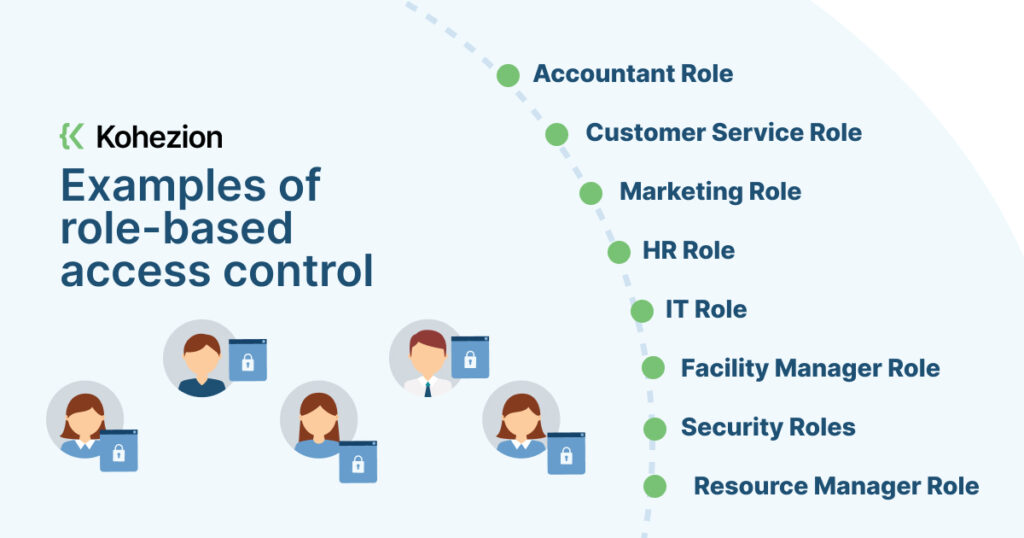
1. Accountant Role
RBAC, when applied to an accountant role, safeguards financial data and ensures regulatory compliance. This approach assigns tailored access privileges, limiting unauthorized alterations and data breaches. Access for accountants may include read and write permissions for financial databases, report generation capabilities, access to budgeting tools, payroll system management, and oversight of vendor databases for invoice handling and payment tracking.
2. Customer Service Role
Incorporating RBAC into the Customer Service role tailors permissions to responsibilities, providing necessary access while safeguarding sensitive information. RBAC ensures customer service representatives access only relevant resources required for effective issue resolution and inquiry handling. This framework mitigates the risk of unauthorized data access or misuse, fostering customer privacy and organizational security.
3. Marketing Role
RBAC implementation for the Marketing role ensures controlled access to essential marketing functions. It streamlines permissions, allowing tasks like newsletter creation, social media management, and analytics access. Marketing teams gain authority to handle advertising campaigns and collaborate with design teams for content creation and refinement. This structured access ensures efficiency while safeguarding sensitive marketing resources.
4. HR Role
In RBAC implementation, the HR role ensures data security and confidentiality. HR collaborates with IT and security teams to define roles accurately, aligning them with organizational objectives and regulations. HR analyzes workforce needs and aids IT in creating precise access permissions and minimizing access errors. They maintain the principle of least privilege, granting only essential access to prevent data breaches. HR manages permissions during onboarding and offboarding, ensuring accurate access assignments and updates.
5. IT Role
The IT role in RBAC implementation revolves around technical expertise, configuration, and collaboration. IT professionals possess technical knowledge to design and maintain RBAC systems, ensuring compatibility with existing infrastructure. They configure RBAC, define roles, and manage permissions, collaborating with various stakeholders to align the system with business objectives. IT conducts role and access discovery, tailoring roles to specific departmental needs. They also maintain roles to adapt to IT infrastructure changes, troubleshoot system issues, and address access-related problems.
6. Facility Manager Role
In the context of role-based access control (RBAC), a Facility Manager oversees an organization's physical facilities, ensuring their safety and functionality. Specific access control privileges may include managing security systems like CCTV and alarms, administering keys and locks, controlling physical access to different areas, accessing resources for maintenance and repair, handling safety protocols and emergency response plans, and managing vendor information and contracts related to facility services.
7. Security Roles
Security roles within an organization are vital for controlling and managing access to resources, applications, and data. These roles include responsibilities such as standard user access, managerial oversight, system administration, IT support, data ownership, auditing for compliance, security and system management, strategic decision-making for executives, access to external partners or vendors, and compliance with legal and regulatory requirements. Each role has associated permissions that align with their responsibilities, granting access levels essential for fulfilling their duties within the organization.
9. Team Lead Roles
Team leads are responsible for overseeing and managing a team within an organization, and as such, they are typically granted specific permissions and privileges to carry out their role effectively. Examples of the specific permissions and privileges typically assigned to team leads include the ability to create and manage user accounts for their team members, access to team-specific documents and files, the authority to assign and revoke access permissions for their team members, and the ability to monitor and track their team's activities within the system.
Team leads also may also have elevated privileges that allow them to perform certain administrative tasks, such as generating reports or managing team-specific resources. Clearly defining and implementing team lead roles within an RBAC system is of utmost importance as it ensures that team leads have the necessary access to perform their responsibilities while also maintaining security and preventing unauthorized access. It helps streamline the access control process, enhances accountability, and promotes efficient collaboration within the organization.
10. Executive Roles
Executive roles define access levels for top-level stakeholders, ensuring proper access to vital resources. These roles need clear definitions and alignment with the organizational structure, involving input from various departments. They determine access to sensitive data, often holding elevated privileges for critical decision-making and accessing confidential information. Hierarchical in nature, they limit sensitive information access based on responsibilities.
Customizable within RBAC solutions, these roles can adapt to specific organizational needs. Defining them requires coordination and collaboration across departments, preventing misalignment with company objectives. Ultimately, these roles maintain resource security, aligning access with responsibilities and reducing unauthorized access risks.
Conclusion
Implementing Role-Based Access Control (RBAC) brings significant advantages such as simplified user privilege management, improved security and compliance, and increased organizational efficiency. However, challenges like system setup complexity and potential human errors should be acknowledged. With careful planning and regular reviews, a well-implemented RBAC system can enhance overall security and streamline access control in your organization.
Start building with a free account
Frequently Asked Questions
Implementing RBAC involves these steps: analyze business needs for access requirements and compliance, define the implementation scope around sensitive data systems, carefully design roles to match job functions without common pitfalls, document changes and create clear policies, stage the rollout for smoother integration and feedback, and continuously adapt by evaluating and refining the RBAC model to suit evolving organizational needs and security trends.
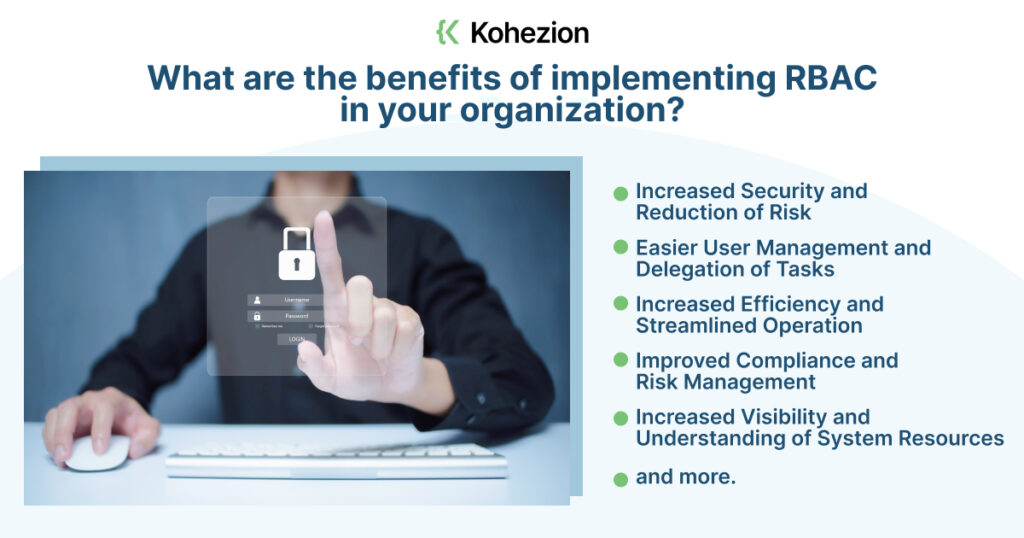
When implementing RBAC, consider these data points: business functions and technologies to determine access needs, regulatory requirements for compliance-driven roles, current security status for vulnerability insights, a focused implementation scope for manageability, meticulous role design to avoid pitfalls, clear documentation for role understanding, phased rollout to gather feedback, and ongoing evaluation to adapt to evolving business needs and threats for effective access control management.
RBAC aids compliance as it structures access control, ensuring authorized access to sensitive data, and facilitating adherence to federal, state, and local regulations like HIPAA and SOX. It automates access rights manages data access effectively and enhances operational efficiency, meeting statutory requirements for confidentiality and privacy. RBAC’s role-based approach decreases the risks of breaches, optimizes resource usage, and supports auditing, demonstrating effective resource management for compliance.
These risks include misalignment of roles and permissions, creating security gaps and compliance challenges, frustration and friction for users, the potential for blunders in security administration, and overreliance on RBAC as a sole cybersecurity measure. Misalignment of roles and permissions can occur when individuals are given too many permissions or assigned to too many roles, resulting in security vulnerabilities. This can lead to security gaps and compliance challenges, undermining the initial purpose of implementing RBAC.
Also, errors in security administration can occur when granting individual permissions, whereas changing access within a role reduces the likelihood of giving someone excessive or insufficient power. Do not solely rely on RBAC as a preventative control, as hackers can still find ways to gain unauthorized access.
To keep your RBAC implementation current, conduct regular reviews of roles and access, collect feedback and monitor access patterns to adapt roles to changing needs, educate employees on security best practices, establish a clear policy for RBAC usage, welcome input for system optimization, enforce security protocols, and consider complementing RBAC with Attribute-Based Access Control (ABAC) for scalability.
To effectively monitor and audit your RBAC implementation, consider these methods: analyze access logs for suspicious activities or breaches, conduct regular access reviews involving managers and users, perform compliance checks against industry standards, utilize specialized RBAC tools for automation and centralized management, and emphasize continuous monitoring to adapt to changes and proactively address any emerging issues in alignment with business goals and security needs.
